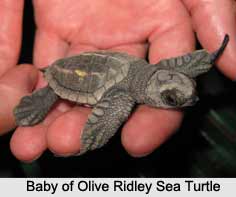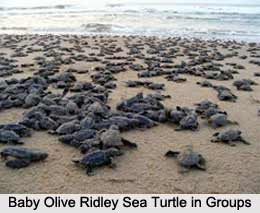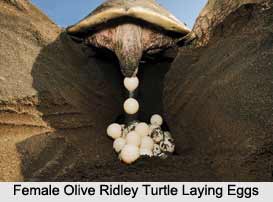 Olive Ridley Sea Turtle is an Indian Marine Species that bears a scientific name "Lepidochelys olivacea" and is also known as the Pacific Ridley Sea Turtle. It is a medium-sized species of sea turtle found in warm and tropical waters, primarily in the Pacific Ocean and Indian Ocean.
Olive Ridley Sea Turtle is an Indian Marine Species that bears a scientific name "Lepidochelys olivacea" and is also known as the Pacific Ridley Sea Turtle. It is a medium-sized species of sea turtle found in warm and tropical waters, primarily in the Pacific Ocean and Indian Ocean.
Structure of Olive Ridley Sea Turtle
The Olive Ridley Sea Turtle is a small sea turtle, with an adult carapace length averaging from 60 to 70 cm. The heart-shaped carapace is characterized by four pairs of pore-bearing inframarginal scutes on the bridge, two pairs of prefrontals, and up to 9 lateral scutes per side. Olive Ridleys are unique in that they can have variable and asymmetrical lateral scute from 6 to 8 counts ranging from five to 9 plates on each side, with six to eight being most commonly observed. Each side of the carapace has 12-14 marginal scutes.
Body of Olive Ridley Sea Turtle
The carapace of Olive Ridley Sea Turtle is flattened dorsally and highest anterior to the bridge. It has a medium sized, broad head that appears triangular from above.  The head`s concave sides are most obvious on the upper part of the short snout. It has paddle-like forelimbs, each having two anterior claws. The upperparts are greyish green to olive in colour, but sometimes appear reddish due to algae growing on the carapace. The bridge and hinge less plastron of an adult varies from greenish white in younger individuals to a creamy yellow in older specimens.
The head`s concave sides are most obvious on the upper part of the short snout. It has paddle-like forelimbs, each having two anterior claws. The upperparts are greyish green to olive in colour, but sometimes appear reddish due to algae growing on the carapace. The bridge and hinge less plastron of an adult varies from greenish white in younger individuals to a creamy yellow in older specimens.
Hatching of Olive Ridley Sea Turtle
Hatchlings are dark grey with a pale yolk scar, but appear all black when wet. Carapace length ranges from 37 to 50 mm. A thin, white line borders the carapace, as well as the trailing edge of the fore and hind flippers. Both hatchlings and juveniles have serrated posterior marginal scutes, which become smooth with age. Juveniles also have three dorsal keels; the central longitudinal keel gives younger turtles a serrated profile, which remains until sexual maturity is reached.
Behaviour of Olive Ridley Sea Turtle
Olive Ridley Sea Turtle has a circum-tropical distribution, living in tropical and warm waters of the Pacific and Indian Oceans from India, Arabia, Japan, and Micronesia south to southern Africa, Australia and New Zealand. In the Atlantic Ocean, it has been observed off the western coast of Africa and the coasts of northern Brazil, Suriname, Guyana, French Guiana and Venezuela.  Additionally, the Olive Ridley has been recorded in the Caribbean Sea as far north as Puerto Rico. It is also found in the eastern Pacific Ocean from the Galapagos Islands and Chile north to the Gulf of California, and along the Pacific coast to at least Oregon Migratory movements have been studied less intensely in Olive Ridleys than other species of marine turtles, but they are believed to use the coastal waters of over 80 countries.
Additionally, the Olive Ridley has been recorded in the Caribbean Sea as far north as Puerto Rico. It is also found in the eastern Pacific Ocean from the Galapagos Islands and Chile north to the Gulf of California, and along the Pacific coast to at least Oregon Migratory movements have been studied less intensely in Olive Ridleys than other species of marine turtles, but they are believed to use the coastal waters of over 80 countries.
Population of Olive Ridley Sea Turtle
The population of Olive Ridley Sea Turtle is in Pacific Mexico and was estimated to be at least 10 million prior to the era of mass exploitation.
Habitat of Olive Ridley Sea Turtle in India
Gahirmatha Beach in Kendrapara district of Odisha is now a part of the Bhitarkanika Wildlife Sanctuary, is the largest breeding ground for these turtles. Gahirmatha Marine Wildlife Sanctuary, which bounds the Bhitarkanika Wildlife Sanctuary to the east, was created in September 1997, and encompasses Gahirmatha Beach and an adjacent portion of the Bay of Bengal.
 Migration of Olive Ridley Sea Turtle
Migration of Olive Ridley Sea Turtle
Olive Ridley Sea Turtles migrate in huge numbers from the beginning of November, every year, for mating and nesting along the coast of Odisha. Gahirmatha Beach has the annual nesting figure between one hundred to five hundred thousand, each year. There has been decline in the population of these turtles in the recent past due to mass mortality.
Feeding of Olive Ridley Sea Turtle
Olive Ridley Sea Turtle is predominantly carnivorous, especially in immature stages of the life cycle. Animal Prey consists of protectorates or invertebrates, which can be caught in shallow marine waters or estuarine habitats. Common Prey items include jellyfish, tunicates, sea urchins, bryozoans, bivalves, snails, shrimp, crabs, rock lobsters, and sipunculid worms.















